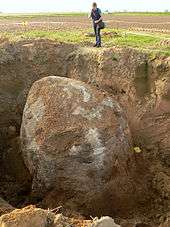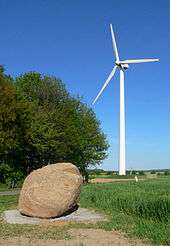Colossus of Ostermunzel

The Colossus of Ostermunzel is a 27.5-tonne stone, a glacial erratic, found in a farmer's field east of Ostermunzel in Lower Saxony, Germany, in 2013.[1][2] It was excavated and moved to a new location a kilometre away.
Location, discovery and excavation
This glacial erratic, a piece of rock that differs from the size and type of rock native to the area in which it rests, was found by a farmer who was ploughing his land in 2013.[3] The field in which it was discovered lies on a small hill near the district road K 253 between Ostermunzel and Dedensen. Upon discovering it, the owner of the field informed local authorities in accordance with the Lower Saxon natural protection law that discoveries of rocks that are more than 2 metres across (6½ ft) must be reported. The Hanover Region objected to its planned demolition.[4]

A preliminary investigation and assessment by Heinz-Gerd Röhling of the State Office of Mining, Energy and Geology (Landesamt für Bergbau, Energie und Geologie) found that the stone qualified as a natural monument.[5] Its large size is abnormal, particularly for northern Germany and especially for Lower Saxony.[6] Due to the estimated €20,000 cost of its removal, the Hanover Region, which was in charge of what to do with the stone, initially decided to leave it where it was discovered. However, after reconsideration, the stone was removed intact in the spring of 2015 by a mobile crane and transported by a low loader to the Mühlenberg hill approximately 1 kilometre (0.6 miles) away for exhibition. Around 400 bystanders witnessed the excavation and transport. The removal costs totaled €15,000, with the expense borne by the Hanover Region.[7] The new site is at a picnic area close to a bicycle path.[8]
Description
The glacial erratic stone's approximate measurements are 2.6 metres (8½ ft) high by 3.2 metres (10½ ft) wide, with a circumference of 10 metres (33 ft). Its weight was originally estimated to be 50 tonnes,[9] but was found to be 27.5 tonnes when it was weighed at the time of its removal from the field where it was found and excavated.[2]
Geologists inspected the stone. It is probably composed of gneiss, estimated to be 1.4 to 1.6 billion years old.[7] The mineral composition was preliminarily observed to be feldspar and biotite. It was brought to the region by a glacier from Scandinavia, probably from Sweden.[8]
 Bystanders during the removal with a crane
Bystanders during the removal with a crane Lifting the glacial erratic
Lifting the glacial erratic Placement on a low loader
Placement on a low loader Transport to the final destination
Transport to the final destination Being lowered into place at the new location
Being lowered into place at the new location The farmer (left) who found the glacial erratic
The farmer (left) who found the glacial erratic
See also
- Der Alte Schwede (English)
- Giebichenstein (English)
- Großer Stein von Altentreptow (German)
References
- ↑ Der Koloss von Ostermunzel – Bergung und Präsentation at the office of regional development Leine-Weser.
- 1 2 Erfolgreiche Bergung des Findlings von Ostermunzel on hannover.de of 17 April 2015.
- ↑ Schwerlastkran versetzt Naturdenkmal Ostermunzel. In: Land & Forst of 20. April 2015
- ↑ Hendrik Lullies: Region Hannover schaltet sich wegen Findling ein. Radio Leinehertz 106.5, 15 August 2014.
- ↑ Wie ein Milliarden Jahre alter Stein die Geheimnisse der Eiszeit lösen könnte in focus.de of 16 March 2015
- ↑ Klaus Abelmann: Gehoben und verschoben: Der Findling von Ostermunzel in: Deisterjournal.
- 1 2 27-Tonnen-Stein kommt ins Rollen in: Die Welt of 17 April 2015.
- 1 2 Region Hannover lässt Findling bergen on hannover.de of 24 February 2015.
- ↑ LBEG Niedersachsen: Gestein des Jahres 2015: Pünktlich zur Ehrung taucht riesiger Gneis auf Press release of 13 January 2015.
External links
| Wikimedia Commons has media related to Findling (Ostermunzel). |
- Jörg Rocktäschel: Findling auf Acker muss zertrümmert werden. Hannoversche Allgemeine Zeitung, 14 August 2014
- Jörg Rocktäschel: Findling wird nicht zertrümmert. Hannoversche Allgemeine Zeitung, 14 August 2014
- Carsten Fricke: Findling ist ein Naturdenkmal. Hannoversche Allgemeine Zeitung, 2 September 2014
- Photo of the glacial erratic about the topic Gneis als Stein des Jahres 2015, on www.NDR.de of 13 January 2015
- Riesen-Stein ist leichter als gedacht on www.NDR.de of 17 April 2015
- Video of Hannoversche Allgemeine Zeitung
- Video of Sat.1 Regional
Coordinates: 52°22′36″N 9°30′07″E / 52.37676°N 9.50202°E